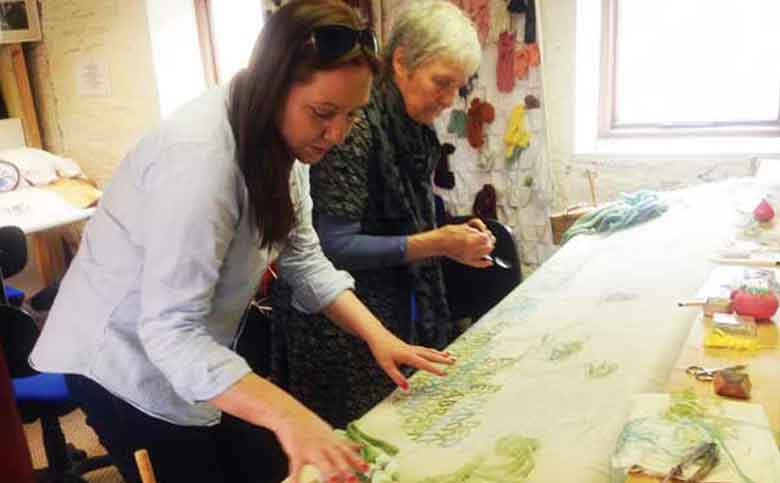The story of New Ross and the tale of The Marshal and Isabel, woven in thread, is a treasure of Ireland’s Ancient East.
Contact Details.
The Ros Tapestry Exhibition Centre,
The Quay,
New Ross,
County Wexford.
Phone – 00353 (0)51 445396
E-mail – infor@rostapestry.ie
Website www.rostapestry.ie
Opening Times.
The Ros Tapestry is open to visitors 7 days a week throughout the year.
Monday – Saturday 10AM – 5PM
Sunday 11AM – 3 PM
Admission Fees 2017
Adult – €8.00
Senior – €7.00
Student/Child – €6.00
Family (2 Adult and 3 Children) – €23.00
Group Rates are available for a minimum of 12 people.
Adult – €7.00
Senior – €6.00
Student/Child – €5.00
Tour Details
Tours of the Ros Tapestry are by Audio Guide and are available in English, German, French and Italian
Sinead’s Thought’s on The Ros Tapestry Experience.
The Ros Tapestry is the epic tale of the foundation and history of the medieval town of New Ross and the Norman Conquest of Ireland told in thread through a series of exquisite tapestries. No trip to the South East of Ireland would be complete without a visit to New Ross to visit the magnificent and breathtaking wonder that is The Ros Tapestry.
On my way to New Ross, County Wexford, to visit The Ros Tapestry, I found myself recanting the tale of New Ross and its historical foundation. Every one of us has a favorite character in history and on this trip I got to recount the tale of one my personal favorites, The Norman Knight William Marshall, also referred to as “The Greatest Knight That Ever Lived”. The Ros Tapestry tells of Marshall and his beautiful wife Isabel de Clare, their roots and histories and how they came to found and develop one of Irelands most important medieval towns. They have left their mark in Ireland in stone but also deep in our memories, reminding us of our own histories and how Ireland was woven into histories most important events.
The Ros Tapestry is a wonderful and dramatic community project that combines the arts and history. Its beauty telling the dramatic and fascinating history that centre’s around the Norman conquest, establishment of New Ross and the famous historic figures that created this unique and epic story. The idea of for the Ros Tapestry was born in 1998 and was the brainchild of the Rector of St, Mary’s Church, New Ross, The Reverend Paul Mooney. Dr Mooney working in conjunction with art historian Alexis Bernstorff, who is an expert in the field of tapestry and fabric restoration.
The initial plan was to display The Ros Tapestry in St Mary’s Church in New Ross. Dr Mooney and Alexis Bernstorff worked with Ms Reiltin Murphy to create a visual example of how the Tapestry could be displayed within the Church. The project started with a list of historical subjects. The Countess Ann Griffin Bernstorff offered to design and paint the cartoons that would eventually be made into The Ros Tapestry we see today. The first of these panels would depict Hook Lighthouse in its original medieval form; this panel was stitched in Fethard-on-Sea. Possibly one of the most beautiful aspects of The Ros Tapestry is its attention to historical detail, as each panel has been stitched in or as close as possible to the sites where the depicted events occurred.
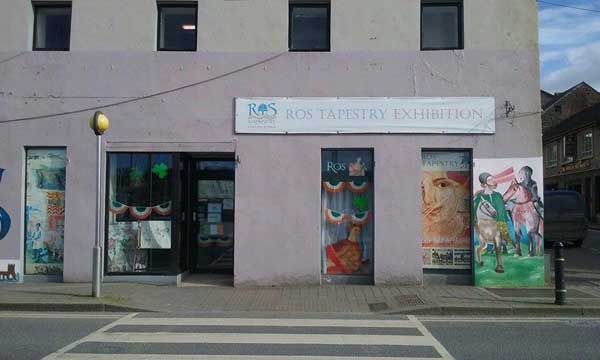
Alexis Bernstorff began training and supervising stitcher’s who would in a combined effort produce these magnificent works of arts. Over 14 years, 150 volunteers gave their time and devotion to the creation of The Ros Tapestry. Today 14 of the 15 panels are complete and reside in the Ros Tapestry Exhibition Centre, located on The Quay in New Ross. Looking at each of the individual panels, I was in complete awe of the work, skill and commitment that has been stitched into every inch of The Ros Tapestry. Not only is the history of this area of Ireland now eternally preserved in art but is also a testament to the strength and commitment of this wonderful community and the volunteers that gave their time so generously to ensure that the history of there area will never be forgotten. Their love and skill is evident in every stitch.
All 15 panels tell in detail the history and legends surrounding New Ross and The Norman Conquest of Ireland. It also tells the story of the Greatest Knight that ever lived William Marshal and his connection to Ireland and some of Ireland most historic and important events. Each of the 15 panels exquisitely depicts our history in glorious colour and detail. Each Panel contains a wealth of information, with a large main image, flanked by upper and lower boarders full of images and depicting characters and events that grace our history books and imaginations.
If you are visiting in the area I would strongly advise everyone to visit The Ros Tapestry. As I walked around the exhibition room I was rendered speechless by the beauty and exquisite craftsmanship of what I was witnessing. The staff at The Ros Tapestry are amazing and are extremely informed on all aspects of The Ros Tapestry and its history, I was also given the honor of putting a stitch in one of the new projects, it was one of the most amazing experiences I have had on my travels throughout Ireland’s Ancient East. I have seen tapestries before but nothing like this, this work of art is a gift to future generations, this is not just a Tapestry it is an epic historical production. My Real Ireland will definitely be returning to visit The Ros Tapestry. We would advise anyone planning a trip to this area, to take the opportunity to visit The Ros Tapestry, as it is a complete guide to the history of this area. I have began using the stories depicted in the panels to guide me on my trip through the South East of Ireland and to walk in the footsteps of The Marshall and Isabel de Clare.
The Panels and Legends of the Ros Tapestry.
We have decided to give you a brief history of each panel, we will describe the events in each panel but we have also decided not to tell you everything they depict, as if you have the opportunity to see this amazing work of art, we don’t want to spoil any surprises that each of these panels holds.
1. The Celts – Island Fearness
Long before the Norman Invasion, Ireland was a country with a long established system of law and even by today’s standards, was a legal system that was advanced and centered in social order. These Laws were The Brehon Laws and many of these Brehon Laws were still in use well into the 17th Century. The Laws outlined social order and the rights of people in society, as well as a varied system of compensations and punishments. Issues such as a marriage, divorce, rights to property and inheritance were all covered under this advanced legal system. The Brehon Laws were overseen by Brehon Priests. It is important to remember that Ireland was divided in many Kingdoms with their own Kings, Chiefs and Overlords that ruled over local Tuaths. Some of these even gained enough power and territory that they became known as High Kings. This panel shows us the coronation of an Irish King, performed by Brehon Priests under Brehon Law in a Sacred Oak Grove, in the presence of a white mare, who is a representation of the goddess of the earth. The boarder depict the world of the Celts, women warriors who were an essential part of this society, Queen Meabh and severed heads, taken from dead enemies by the Celts, they believed that the power and spirit of the warrior resided in the head.
2. The Abduction of Dervogilla.
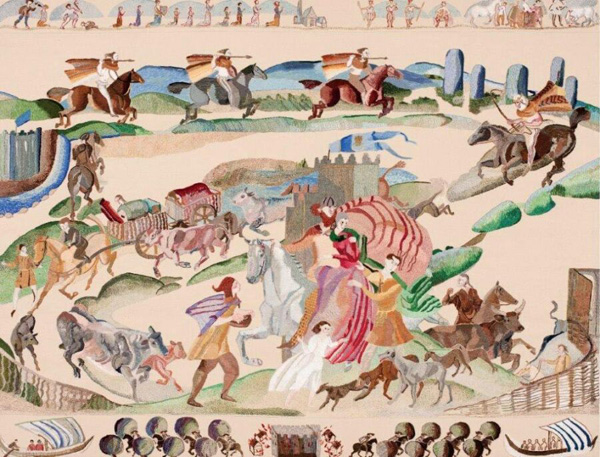
Dervogilla was the wife of Tiernan O’Rourke, the King of Breffni, who was abducted (or ran away with) Dermot MacMurrough, King of Leinster, the sworn enemy of her husband. Under the Brehon Law Dermot was liable to pay her insulted husband 100 ounces of gold, which he did not do and this in turn lead to one of Ireland’s most important historic events. Dermot made many enemies and lost his Kingdom resulting in him seeking foreign help in the form of the Normans. In this panel we see the pair riding to Dermot’s stronghold in Ferns, Co. Wexford with Dervogilla’s dowry. The upper boarder shows the life of the young Dermot and the stories surrounding his early life, enemies and family including the tragic story of his son and heir. The bottom boarder depicts the Forest of Duffry near Enniscorthy which was the location of the Sacred Ancient Oak Forest and also contains an image of Dermot burning his stronghold at Ferns so as it could never be used against him.
3. Arrogant Trespass – The Normans Landing at Bannow Strand.
After seeking the permission of Henry II to recruit Norman warriors to regain his lost Kingdom of Leinster, Dermot MacMurrough’s requests were granted in 1169, when the first wave of 30 Norman Knights and 300 soldiers landed at Bannow Strand in May of that year. These Knights were mainly from the Welsh Marshes, most of who were related or at least knew each other; they were all in search of fortune and lands. The Cavalry and new military technologies must have been an intimidating sight. They were lead by Robert FitzStephen. The colours, armor and weaponry would have shocked the Irish who would never seen anything like them in their lives. The top boarder shows the story of Dermot’s visit to the court of King Henry II in Aquitaine, in France and his subsequent visit to the Welsh Normans. The bottom boarder shows the life of Robert FitzStephen. It also depicts Alice of Abergavenny who was brutal on the battlefield.
4. The Siege of Wexford.
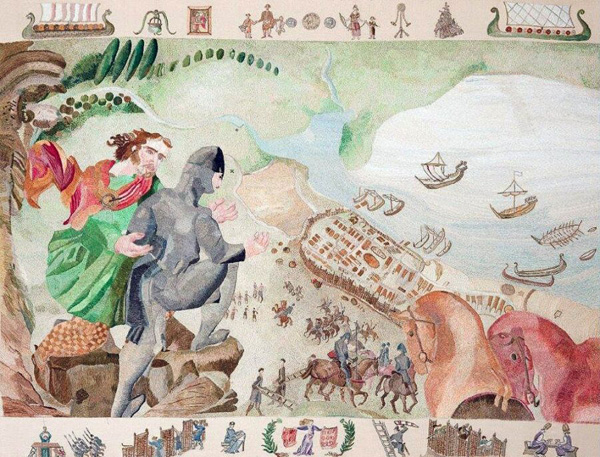
This panel depicts Robert FitzStephen, Dermot MacMurrough and their forces, in their attack on the Norse stronghold of Wexford, their first target of their military campaign in Ireland. MacMurrough promised FitzStephen the town of Wexford in their negotiations but it had not been his to give. It was a Norse stronghold and independent of Irish Kingdoms. Wexford had never before been taken; they were prepared for the Norman assault. The panel shows the military tactics that the Normans would have used against the town of Wexford and the defenses used by the Norse. Their only option was to put Wexford under siege. The Bishop of Ferns however entered the town and negotiated with the Norse and reached a settlement with Dermot. The upper boarder depicts Viking life in Wexford. The lower boarder shows the wattle battlements of Viking Wexford as well as an image of the Princess Nessa of Wales.
5. Battles in the Kingdom of Ossory.
This panel is still a work in progress and is being stitched in Rothe House, Co. Kilkenny. It will depict the Battle of Ossory in Co. Kilkenny. Dermot MacMurrough and Mac Giolla Padraig were vicious enemies; he had played an important role in the deposing of MacMurrough as King of Leinster and had blinded his son. The battle came in waves and destroyed the forces of Mac Giolla Padraig, it is said that the river flowed red with blood. This panel will be breathtaking when complete, as it will depict a full battle scene.
6. The Marriage of Isabel de Clare and William Marshal.
Two marriages forever changed the course and future of Irish history for the next 800 years. This panel depicts Aoife the daughter of Dermot MacMurrough and Mor O’Toole agreeing to take the hand of Richard de Clare, Earl of Pembroke (Strongbow) in marriage. This would allow Strongbow to lay claim to the Kingdom of Leinster. The panel also depicts the marriage of their daughter Isabel to William Marshal “The Greatest Knight that ever lived”. This marriage took place at Stoke d’Abernon in Surrey. At the age of 4 Isabel became heir to her fathers lands and was made a Ward of The Crown. Her marriage to Marshal made him one of the richest men in the kingdom. They had a happy marriage and had 5 sons and 5 daughters. The panel depicts the properties of the couple. The upper boarder shows Marshal’s Viking and Norman connections and the Celtic roots of Isabel and St Laurence O’Toole, Isabel’s Gran Uncle. The bottom boarder shows Isabel being transported from the Tower of London to her marriage and honeymoon location. It also depicts their children.
7. William Marshall – The Flower of Chivalry.
Known as the Greatest Knight that ever lived, a man who served some of histories most infamous Kings. The Marshal was a man of humble beginnings, who rose to fame as a tournament Knight. He served in Royal Courts and carved his own history into Battlefields. He saved the life of the wife of Henry II, Eleanor of Aquitaine, this lead to his path of greatness serving in the Medieval Royal Courts of Kings. He tutored King Henry the Younger in the ways of Knights and the code of chivalry. Henry II granted him the hand of Isabel de Clare, and he would eventually rise to the title of Earl of Pembroke and Lord of Leinster. He was a warrior, a Knight, a crusader and the right hand of Kings. A man that rose from nothing to being instrumental in the foundation of Magna Carta and became Regent and defender of the Kingdom of the 9 year old Henry III. The top and bottom boarders depict important events in the life of The Marshall including his death as a Templar Knight and was buried in the Temple Church in London.
8. Ex Voto Tintern Abbey – William Marshal’s Stormy Crossing to Ireland.
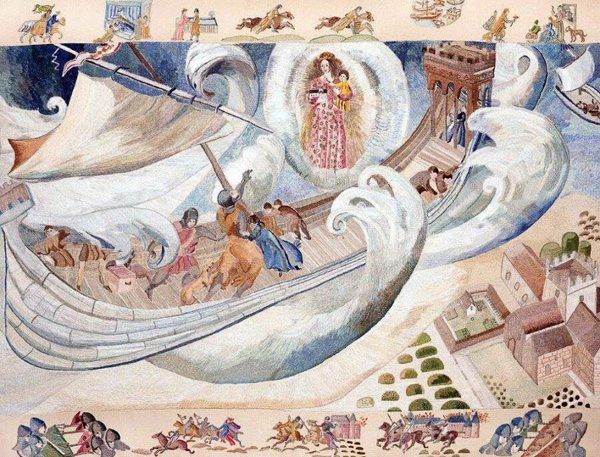
Upon his marriage of Isabel de Clare, William Marshal would also inherit all that lands and titles that Isabel brought with her. Henry II granted permission to marry Isabel on his deathbed, upon the death of the King his Heir Richard The Lionheart was forced to also agree to the marriage but they did not travel to the Kingdom of Leinster until 11 years after their marriage. King John finally granted them Royal permission to visit their estates in Ireland. The Marshal, Isabel and some of their children began their journey to Ireland (2 of their sons had to stay behind as the hostages of John I) they sailed though violent and vicious storms, that almost destroyed their fleet. Marshal swore a vow to the Virgin Mary that if they survived he would build a Cistercian Abbey at the site of their arrival. This vow was fulfilled in the form of Tintern Abbey Minor, constructed at Saltmill in South Wexford. The upper panel shows the death of Henry II and the Marshall riding to The Tower of London to meet his bride before the order could be rescinded by The Lionheart. The bottom boarder shows The Marshall protecting Henry II during a turbulent time with his sons.
9. Hunt in the Forrest of Ros.
This panel depicts The Marshal, Isabel and her Irish relatives hunting in the Forest of Ros. They had a passion for hunting and the lands they owned were full of wild life. We see stags and wild boar. Isabel’s Irish relatives would have guided the couple through the estates. The Marshall’s love of horses was essential in forming a bond with his new Irish Cousins. Irish wolfhounds and deerhounds are also depicted. The boarders show Norman hunting practices as well as prey.
10. Gothic Glory – The building of the Parish Church of St. Mary’s in 1210.
The Marshall and Isabel began the building of New Ross in 1207. Their aim was to create a thriving port and town to compete with Waterford. They began construction of St. Mary’s in approximately 1210. It is one of the most glorious early period Irish Gothic Churches. Isabel was instrumental in its design and construction. It is thought that Isabel’s heart resides in a heart shaped shrine within the Church. The panel depicts the couple observing the building processes; most of the materials used were imported thought the port of New Ross. The upper boarder contains depictions of Saints from Wexford and their stories. The lower boarder shows the ships sailing from Bristol to the new port of Ros. The stone used in the construction of St. Mary’s was imported from Wales.
11. Evening – The Lighthouse at Hook Head.
Where the Rivers Barrow, Nore and Suir meet we start to know them as The River of the Three Sisters. Guarding the estuary is the world famous Hook Head Lighthouse, County Wexford. This panel depicts the construction of the Lighthouse by William Marshall, he needed to protect his trading ships traveling to his new port of Ros. It shows Reymond Le Gros overseeing the beacon and its maintenance. The Lighthouse has been operational since the 5th Century, when it was a simple fire cared for by monks and is still a working Lighthouse, making it one of the World’s oldest functioning lighthouses.
12. The Thriving Port of Ros.
William Marshal and Isabel built the port town of New Ross on the banks of the River Barrow. This opened up the Leinster trade routes and the area became open to the thriving international market. The Marshal was famous throughout Europe and found many willing to help him build his new port, such as the Italian bankers we see in this panel. New Ross became one of Europe’s busiest ports. The scene in the panel depicts the year of approximately 1220; with its varied cultures and nationalities it was a magnificent sight. Throughout this panel we are shown the goods that would have passed through the port such as wool and wine. The port of Ros could hold up to 400 ships at a time.
13. The Walling of Ros – Sixteen Guilds Protect Their Town.
The Norman town of Ros initially had no protective wall for the first 60 years of its existence it was vulnerable except for the fact that The Marshal’s Wife Isabel’s, Gaelic Family ruled large parts of the area. However when the Norman Lords Walter de Burgh and Maurice FitzGerald fought over terrority Ros became vulnerable. This panel shows the next period in the history and development, of Ros and this is also described by a Trovere, in a manuscript that is now held in the British Museum. The guilds of Ros decided to defend their town and drew up a plan to build a wall around Ros. The townspeople and the Guilds of the town took on this major project. They dug a ditch 1km around the town and it was 20 feet wide. All 16 guilds partook in this massive project and the town’s ladies worked on Sundays. The panel shows the building of the wall, including the massive contrabution that the woman of the town made in the construction of this defensive system.
14. Exchange – The Irish and Normans Mingle at the Fair.
This panel shows us what a day at a fair in Ros would have looked like. The wealth and prosperity that The Normans brought with them was starting to become apparent. Ros enjoyed 4 fair days a year, the most granted to an Irish town at that time. People had a chance to sell their produce and enjoy themselves. The panel shows how Ros had become powerful and prosperous. Italian bankers and tax collectors’ are seen with their chequered cloth. This is where the word exchequer comes from. In the boarders you can see goods for sale including Irish Wolf Hounds and Deer Hounds. The bottom boarder shows another side of the fair as prisoners met their fate. This panel also depicts the ties between Ros and the wider Norman World.
15. The Sheaf of Corn – The Distaff Descent.
This exquisite final panel in the Ros Tapestry depicts the 5 daughters of The Marshal and Isabel as they sing and play music in a garden. Aoife sits alone protected by the MacMurrough emblem, which is a sheaf of corn. Her influence reigning over the bloodlines of the most powerful Norman families in history. She married Strongbow, and her daughter married The Marshal; in turn their 5 daughters married powerful Norman Lords. The Son’s of The Marshall and Isabel died without issue, so all lands, rights and inheritances would pass to the female line. This tapestry show the power of the female line and how 2 women influenced the fate of Ireland by joining the Gaelic Irish and The Normans through marriage and how their decedents influenced Irish history.

